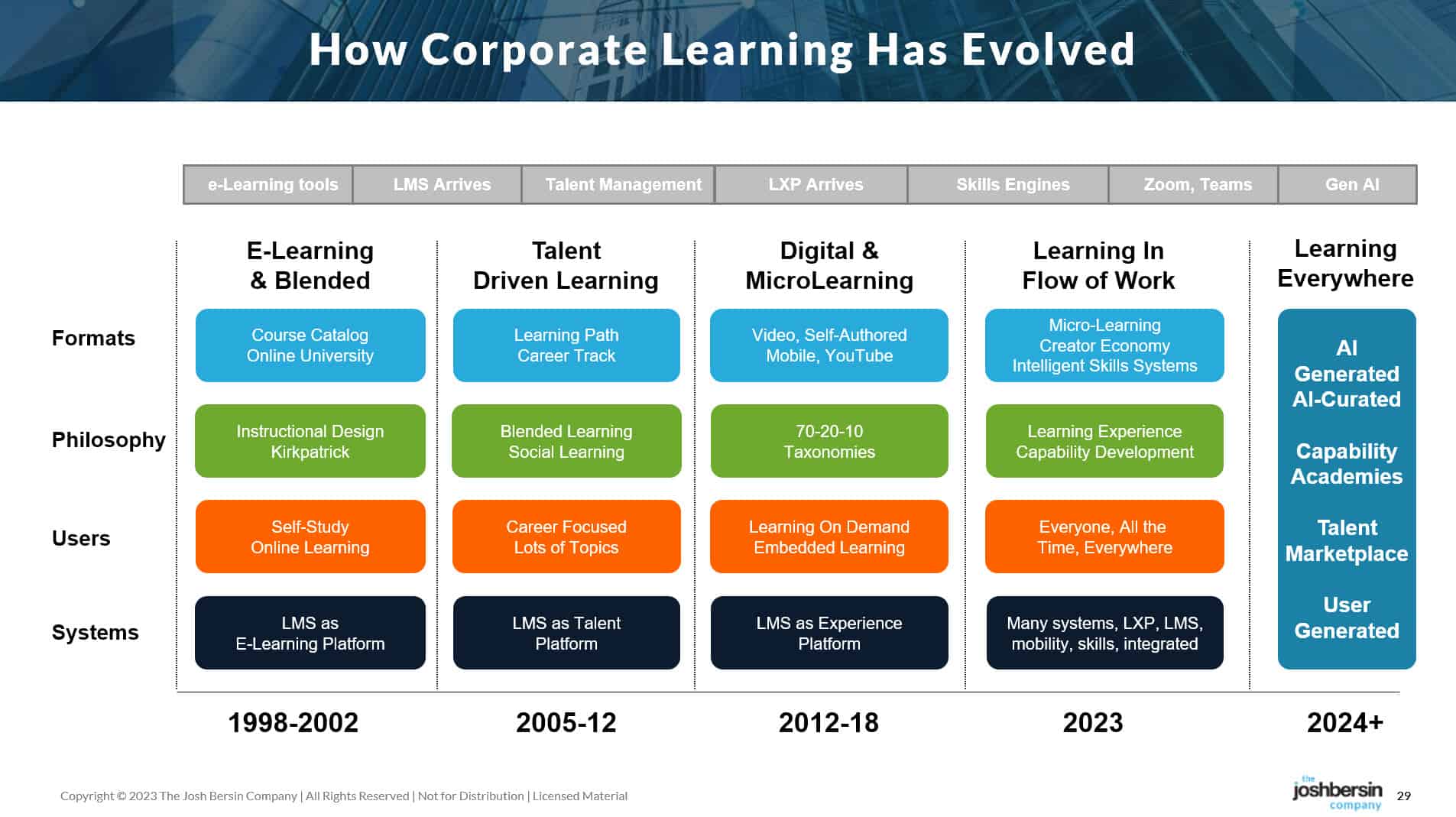
*The original article is from the Josh Bersin Academy.
Among all domains influenced by artificial intelligence, the most significant transformation is arguably happening in corporate learning. After a year of trials, it has become evident that AI is set to revolutionize this area.
Let’s discuss the essence of Learning & Development (L&D). Corporate training is omnipresent, hence a market size of $340 billion. Every aspect of work (from onboarding to expense reporting to complex operational procedures) requires some form of training. Even in economic downturns, corporate expenditure on L&D maintains a steady average of $1200-$1500 per person.
However, as L&D professionals are aware, the issue is quite complex. There are hundreds of training platforms, tools, content libraries, and methodologies. I estimate the L&D technology sector to be worth over $14 billion, not even counting systems like search engines, knowledge management tools, and platforms like Zoom, Teams, and Webex. Over the years, we have seen several evolutions: e-learning, blended learning, micro-learning, and now, learning in the flow of work.
Generative AI is about to permanently alter all this.

Consider the challenge we face. Corporate training isn’t just about teaching; it’s about creating a learning environment. Traditional instructional design, which is teacher-led and process-oriented, often doesn’t quite meet the mark in the workplace. People learn in various ways, often without a teacher, by seeking reference materials, mimicking others’ actions, and relying on managers, peers, and experts for assistance. Thus, traditional instructional design models need to be expanded to help individuals learn what they need.
Enter generative AI, a technology designed to synthesize information. Generative AI tools like Galileo™ can understand, consolidate, reorganize, and deliver information from a vast corpus in ways that traditional instructional designers could not. This AI-driven approach to learning is not only more efficient but also more effective, facilitating learning in the flow of work. Users can inquire anything they wish, receiving answers pertinent to their needs.
In the early days, learning in the flow of work involved searching for information and hoping something relevant would be found. This process was time-consuming and often fruitless. Generative AI, with its neural networking magic, is now ready to solve these problems, acting as a Swiss Army knife for L&D.
Here’s a simple example. I asked Galileo™, powered by 25 years of research and case studies, “How do I handle an employee who’s always late? And can you provide a narrative to help?” Instead of directing me to a management course or showing a bunch of videos, it directly answered the question. This type of interaction is the direction much of corporate learning is headed towards.

Let me summarize four major applications of AI in L&D:
Content Generation: AI can significantly reduce the time and complexity involved in creating content. For instance, the mobile learning tool Arist has an AI generation feature, Sidekick, that can transform comprehensive operational information into a series of instructional activities. What could take weeks or months can now be accomplished in days or even hours.
We use Arist at The Josh Bersin Academy, and our new mobile courses are being released almost monthly now. Other tools like Sana, Docebo Shape, and the user-centric learning platform 360 Learning are equally exciting.
Personalizing Learner Experience: AI can tailor learning paths to individual needs, improving upon traditional models that assign learning paths based on job roles. AI understands content details and uses that information to personalize the learning experience. This method is far more effective than the cluttered Learning Experience Platforms (LXPs) that often fail to grasp content details fully.
Uplimit, a startup dedicated to developing an AI platform to facilitate AI teaching, uses its Cobot and other tools to personalize coaching and tips for technical professionals learning about AI. Cornerstone’s new AI fabric recommends courses by skill, Sana’s platform links tools like Galileo to learning, and the new AI features in SuccessFactors also offer users a curated view of learning based on role and activity.
Identifying and Developing Skills: AI can identify skills within content and infer individuals’ skills, aiding in delivering the right training and assessing its effectiveness. While many companies are working on high-level skills taxonomy strategies, the real value lies in the detailed, domain-specific skills that AI can identify and develop.
Pioneers in talent intelligence such as Eightfold, Gloat, and SeekOut can infer employee skills and immediately recommend learning solutions. We are actually employing this technology for our HR Career Navigator, set to launch early next year.
Replacing Training With Knowledge Tools: One of the most disruptive AI applications in L&D is the potential to entirely replace certain types of training. AI can create intelligent agents or chatbots that provide information and solve problems, potentially eliminating the need for specific training types. This method is not only more efficient but also more effective, providing individuals with the information they need exactly when they need it.
Walmart is implementing this today, and our new platform Galileo is aiding companies like Mastercard and Rolls-Royce in finding HR and policy information on-demand without training. LinkedIn Learning is making its soft-skills content accessible to Gen AI search, and soon enough, the Microsoft Copilot will locate training through Viva Learning.
One crucial caveat here: we will have to teach ourselves (and employees) how to “prompt” these systems. I’m confident our AI tools will become smarter and more conversational quickly, but for 2024, we’re going to spend quite a bit of time teaching users how to prompt AI systems to deliver the answers we seek.



